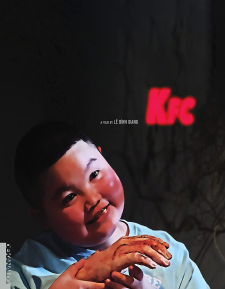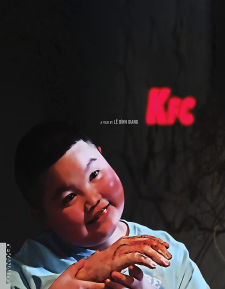KFC (2016) (Blu-ray Review)

Director
Le Binh GiangRelease Date(s)
2016 (October 25, 2022)Studio(s)
Vblock Media Joint Stock Company (Dekanalog/Vinegar Syndrome)- Film/Program Grade: B-
- Video Grade: B
- Audio Grade: B+
- Extras Grade: D
Review
Most films save their legal disclaimers for the end of the closing credits, usually in the form of the standard “no identification with actual persons, places, buildings, and products is intended or should be inferred.” There have been a few, however, that put a disclaimer up front in order to stave off any potential litigation over the subject matter or brands represented. For example, Dusan Makavejev’s The Coca-Cola Kid opened with a title card to make it abundantly clear that its representation of the Coca-Cola company was entirely unauthorized. Le Binh Giang’s 2016 film KFC took that idea one step further by offering a series of four title cards to disassociate itself completely from pretty much everything and everybody:
This is a purely fictional movie.
All the characters and locations you see in this movie are purely fictional.
The story never took place in the past, is not happening in the moment, and will never happen in any future.
Once again, the story in this movie bears no resemblance to any real story.
The fact that KFC prominently features real brands like Kentucky Fried Chicken, Pepsi, and Coca-Cola wouldn’t necessarily have been an issue, since the companies themselves aren’t actually being represented. No, the real issue is everything that happens around them. KFC runs a scant 68 minutes long, but it would have been an endurance test for many viewers at half that length. It’s essentially an impressionistic collage of brutality, depravity, and degradation. It may not be quite as extreme as some other notorious horror films, but it squeezes more extremity into a shorter running time.
KFC unfolds in a series of tableaus involving a group of Hanoi residents who move in and around each other’s orbits, leaving a trail of death and destruction in their paths. There’s no real narrative thread connecting all of it, and yet there is a circularity involved that only becomes clear toward the conclusion. KFC is challenging viewing not just because of the brutality, but also because of the non-linear nature of its story. The lack of any kind of narrative arc means that the film lives in the moment, and so the violence on display in any given scene becomes an end unto itself. There’s no catharsis in any of it, either.
KFC was Le Binh Giang’s debut feature, and just like John Carpenter’s first film Dark Star, it started out as a graduate project at film school, in this case the University of Hanoi. He served as writer, director, producer, and co-editor, so there’s little doubt that KFC clearly represents his own unique vision. How palatable that vision may be is entirely a matter of personal taste. KFC is a gruesomely intense but competently crafted horror film made for very little money, so it definitely demonstrates that Le Binh Giang has real talent. It’s just a difficult to recommend it to anyone. For those with sufficiently strong stomachs, it’s worth a look, but be forewarned that KFC is an unsatisfying film by design.
Cinematographer Nguyen Vinh Phuc captured KFC digitally, framed at 2.39:1 for its theatrical release. There’s no information available regarding the cameras, lenses, or capture resolutions involved, but it does appear that different camera systems were used throughout the film, possibly because of the way that it started out as a film school project before being expanded into a feature film. Some of the sequences were captured at lower resolution on a camera that had limited dynamic range, with visible aliasing and blown-out highlights. Other sequences are sharper and more detailed, with less artifacts. (The earlier footage may have been captured at full frame and then cropped to 2.39:1, which might account for the jaggies on display.) There’s also some instability at times that’s not simply shaky handheld camerawork, but appears to be some kind of technical problem instead. Despite all of those issues, it’s difficult to fault the transfer to disc, since most of them seem to be inherent to the original production. KFC isn’t pretty, but it was never meant to be in the first place.
Audio is offered in Vietnamese 5.1 and 2.0 DTS-HD Master Audio, with removable English subtitles. It’s a subtle but effective mix that surrounds the viewer with environmental sounds like rain, animals, insects, and other urban noise, but everything does spring to active life during a handful of action scenes. The sound effects during the moments of extreme violence are suitably intense.
Dekanalog’s Blu-ray release of KFC is packaged in a clear amaray case that displays artwork on the reverse side of the insert, which is visible when the case is opened. It also includes a 12-page booklet with an essay by Quang Dang and an interview with Le Binh Giang, but unfortunately no notes about the transfer. (That’s still an opportunity for improvement with both Dekanalog and Kani Releasing.) In addition to the booklet, there’s an Easter egg of sorts in the form of a card containing an email exchange to Dekanalog regarding the need for a green band trailer for the film. There was a slipcover available directly from Vinegar Syndrome, but that was limited to 1,000 units, and it’s already sold out. The following extras are included, all of them in HD:
- Mystery Meat: An Interview with Filmmaker Le Binh Giang (10:36)
- Theatrical Trailer – US (1:08)
- Theatrical Trailer – Vietnam (3:09)
In Mystery Meat, Le Binh Giang provides a concise overview of the conception and production of KFC. He covers the writing, casting, makeup effects, and visual effects. He admits that he’s not fond of the CGI that he used in one sequence, and he prefers the practical makeup effects in the rest of the film. For Le Binh Giang, the most important thing in a film is to create emotion for the viewer, so in that regard, he definitely succeeded with KFC.
To say that KFC won’t be for all tastes is a massive understatement, but Le Binh Giang did have a vision for what he wanted to achieve, and that fits perfectly within Dekanalog’s own vision to provide an outlet for unique filmmaking voices from around the world. It will definitely provoke an emotional response in the most jaded of moviegoers.
- Stephen Bjork
(You can follow Stephen on social media at these links: Twitter and Facebook.)

